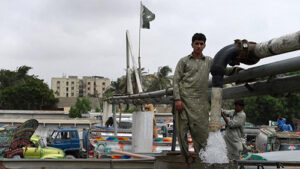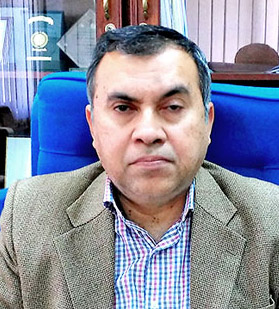With summer 2021 around the corner, peoples’ concerns are rising about the city’s water supply services. As is well known, access to water becomes an even more mounting challenge than usual for ordinary citizens during the high demand for it in summer. With Ramadan fast approaching, common folks’ apprehensions regarding the scarcity of water are undeniably well-founded. It is an issue many will face. About half of Karachi’s population resides in Orangi, Baldia, Qasba Colony, Korangi and Landhi. The water supply situation at the retail level is one of the worst in these localities. People have no recourse but to purchase water from expensive tankers, often having to give up on other essential items as a result. In the process, the possibility of graduating out of the poverty spiral further diminishes.
The options of access to water are limited. They include an erratic supply (where pipelines exist), collusion with area gangs who puncture water mains for commercial sale, boring to obtain what is often semi-brackish water, and purchasing water from tankers. Karachi adds more than 0.6 million people every year to its population, but the bulk water supply does not scale up. For the past several years, the supply has been static — 550 million gallons per day (mgd) against a standing demand of 1.1 billion mgd. The situation is compounded by the fact that only about half the consumers pay their water bill, which is particularly shocking given the extremely low tariff charged. Ironically, the Karachi Water and Sewerage Board’s (KWSB) biggest defaulters include federal and provincial government departments and agencies, which owed the utility over Rs. 22 billion at last count. And this culture of non-payment it seems has now trickled down to the level of the ordinary consumer. A study conducted revealed that many folks consider piped water in urban areas as a gift of nature that does not require any monetary compensation!

Some time ago, the then chief of the water utility is reported to have complained that 95 percent of over 200,000 mosques and imam bargahs do not pay their bills. Meanwhile, water tanker operators pull in much of the revenue that could go towards paying water bills — a sizeable figure, considering it is estimated that over 50,000 tankers are used to buy water every day. Most of these transactions are informal and cash-based in nature, the proceeds of which are believed to be shared among many influential stakeholders at different layers of the water mafia. Ordinary folks, especially in the remote peri-urban locations, remain most affected. The long queues of water tanker-seekers at designated and non-designated hydrants graphically indicate how the conventional piped water system has been rendered dysfunctional in many parts of the city. Central city neighbourhoods and the affluent southern areas heavily rely on supplies through water tankers at exorbitantly high rates. In some places, especially during heat waves, a tanker containing 2,400 gallons can cost up to Rs. 7,500 — or a little over Rs. 3 per gallon! Given the fact that water is one of the most essential elements needed to sustain life, the present water supply system falls glaringly short on every account. As one prominent politician predicted, Karachi may soon experience water riots if the situation is not amended.
The water supply situation cannot, however, improve unless the institutions responsible for it are reformed and made capable of shouldering the range of tasks related to this service. The Supreme Court, in its verdict of March 16, 2017, had extended several suggestions for institutional reforms in the service, and called for compliance by the Government of Sindh, the KWSB, and other government bodies. Among the major tenets of the court order was a revision of the water quota for Karachi — including that for civil society representatives in the KWSB board — fixing the existing water plants, working towards recovering the unpaid water bills from government departments, restricting the use of water hydrants for emergency purposes, installing water meters for bulk consumers, instituting a water supply geographic information system (GIS) for scientific monitoring, working on a priority footing to complete the first phase of the K-IV project (that shall add 260 million gallons of water to the supply quota per day) and revamping the distribution lines so that even tail-end users can benefit from a reliable water supply. The previous Sindh Government had submitted a comprehensive report to the court, committing it would comply with all the court’s directives. The present government has begun taking some steps to this end, including the institutional reform of the water utility of the city. However, much more is needed to address the dire challenge posed by the limited water supply — and this is needed without further delay.

Water supply lines at the bulk and neighbourhood levels must be examined for their performance efficiency. Many of them have outlived their utility while others have been rendered defective due to organised theft or gradual wear and tear. The exercise to rectify the water supply structure must be done after an assessment by a third party technical enterprise to obtain a comprehensive picture. Following that, a rehabilitation programme should be prepared to fix the leaking pipes and joints with priority assigned to remote residential neighbourhoods. Water supply standards and specifications must also be revised as per the current lifestyles and densification of neighbourhoods. It is also important to re-visit the status of revenue collection from the retail and bulk consumers of the service. As stated earlier, while water through tankers costs around Rs. 3 per gallon, the water bills consumers are charged for their piped water are ten times lower. A realistic tariff must be worked out which should be backed by solid financial working to enable the utility to sustain the operation and maintenance of the network. A ‘willingness to pay’ culture also needs to be promoted through specifically devised campaigns for water consumers, many of whom simply refuse to pay the bills. Then there is the precedent of community effort, which has worked well in the past. In Orangi, Baldia and Surjani Town, for example, some years ago local residents of those areas constructed community tanks (awami or people’s reservoirs) for collectively managing and distributing water to less privileged households. These tanks were constructed on public spaces and had a storage provision of about 2000 to 4000 gallons of water each. Once water tankers, purchased through community-pooled funds were procured, water was distributed to those who needed it through canisters under the joint management of the area’s people. Efforts must be made to revive this option which became ineffective several years ago when people were made to believe that piped water would soon be available in abundance. In some remote locations and under-privileged neighbourhoods, the revival of awami tanks has, in fact, already begun by way of philanthropic assistance, as well as self-help mechanisms.
The Indus water source, from where Karachi gets the bulk of its water, is a highly contested source. It can be safely predicted that acquiring additional quantities of water in the future may prove a near impossible proposition. Alternative options, such as desalination, must be explored. There are examples around the world from where we can learn to generate large quantities of water with lesser costs and investments. One of the most efficient large-scale desalination plants was set up in a Middle Eastern territory in 2013. It is capable of generating 160 million gallons of fresh water from the sea at a cost of Rs. 0.25 per gallon or $0.58 per cubic metre. Experts in desalination believe that this is a much lower cost compared to the normal $1 per cubic metre elsewhere in the world. This plant cost around $500 million, but is able to prove its worth by accounting for 20 percent of the water input to that territory’s water supply. Karachi possesses a long coastline and can certainly benefit from desalination after undertaking proper feasibility studies, a review of past attempts (that did not work) and making appropriate engineering improvements. Nowadays technologies are also available to harvest water from the atmosphere. As Karachi maintains a high rate of humidity for most part of the year, it may be useful to instal low-tech small and medium-scale solar and wind-powered atmospheric water generators. It is, however, important to remember that water solutions need to be attempted by cutting bureaucratic red tape. The sooner we embark on approaching some out-of-the-box solutions, the better it will be for improving the quality of life for the millions in this city.

The writer is an academic and researcher based in Karachi.

